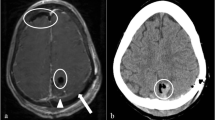Abstract
The long-term functional outcome of 101 children born with meningomyelocele between 1971 and 1981 was assessed, by a combination of retrospective chart review and follow-up assessments. The children had been managed at birth using a process ofnonstandardized selection. Eighty-three of the 101 patients survived after a minimum follow-up of 8.6 years, for a mortality rate of 18%. Forty-four of 83 children (53%) were community ambulators, and this correlated well with the presence of intact quadriceps function. Forty-eight children (58%) attended normal school and were grade-appropriate. Sixty-two of 83 patients (75%) were socially continent of urine, and 71/83 (86%) were socially continent of stool. Hydrocephalus was present in 93 of the 101 children in the study, and 85 children were shunted. Half of the shunted children required a shunt revision in the first year of life, and thereafter the rate of revision decreased, so that after 2 years the risk of revision was approximately 10% per year.
Similar content being viewed by others
References
Ames M, Schut L (1972) Diagnosis and treatment. Results of treatment of 171 consecutive myelomeningoceles — 1963 to 1968. Pediatrics 50:466–470
Laurence KM (1964) The natural history of spina, bifida cystica: detailed analysis of 407 cases. Arch Dis Child 39:41–57
Lorber J (1971) Results of treatment of myelomeningocele. An analysis of 524 unselected cases, with special reference to possible selection for treatment. Dev Med Child Neurol 13:279–303
Lorber J, Salfield S (1981) Results of selective treatment of spina bifida cystica. Arch Dis Child 56:822–830
McLone DG (1983) Results of treatment of children born with a myelomeningocele. Clin Neurosurg 30:407–412
McLone DG, Naidich TP (1989), Myelomeningocele: outcome and late complications. In: Section of Pediatric Neurosurgery of the American Association of Neurological Surgeons (eds) Pediatric neurosurgery: surgery of the developing nervous system, 2nd edn. Saunders, Philadelphia, pp 53–70
McLone DG, Czyzewsky D, Raimondi AJ, Sommers RC (1982) Central nervous system infections as a limiting factor in intelligence of children born with myelomeningocele. Pediatrics 70:338–342
Shurtleff D, Dunne K (1986) Adults and adolescents with meningomyelocele. In: Shurtleff DB (ed) Myelodysplasias and exstrophies: significance, prevention, and treatment. Grune & Stratton, New York, pp 433–448
Soare PL, Raimondi AJ (1977) Intellectual and perceptual motor characteristics of treated myelomeningocele children. Am J Dis Child 131:199–204
Sutton LN, Charney EB, Bruce DA, Schut L (1986) Myelomeningocele — the question of selection. Clin Neurosurg 33:371–381
Author information
Authors and Affiliations
Rights and permissions
About this article
Cite this article
Steinbok, P., Irvine, B., Douglas Cochrane, D. et al. Long-term outcome and complications of children born with meningomyelocele. Child's Nerv Syst 8, 92–96 (1992). https://doi.org/10.1007/BF00298448
Received:
Issue Date:
DOI: https://doi.org/10.1007/BF00298448




